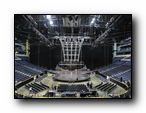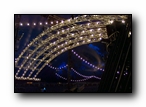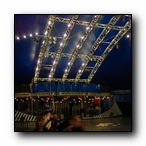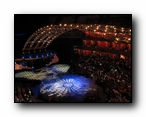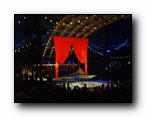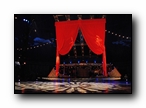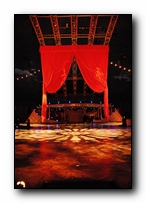
![]()
[ You are here: Grand Chapiteau | Creations | Quidam | Scénographie ]
Création
Expérience
RéserveRetiré
Odyssey
Quidam is totally different from what we've presented up to now, Ste-Crox says. "The show rests on acrobatics still, and our glitter is there. But the theatrical play and emotional setup is different. It's more based on the street." Quidam’s design is stunning. Evoking a monolithic structure like a train station or an airport concourse where people constantly come and go, the minimalist set was created within five months by a team of expert technicians from Cirque's workshops. In every city, some 40 hours of work by about 50 technicians are required to erect the sets under the blue-and-yellow Big Top. The idea came from a discussion of the end of the 20th century, he says. Trying to feel where the world was at and where we were at in that world. "We were at the end of the millennium and had the possibility to communicate with anyone, but we were more individually isolated. We didn't know our neighbors, but we could speak with people in Russia with our computers. That's the paradox we're all living."
"For all of our shows up to this one, we had to work around the acrobats coming into the middle of the set and getting rigged up, and then climbing, trying to make it look organic and natural. We wanted to avoid that this time, so we designed a system of tracks on which they could make their entrance. That led to the idea of making the set itself a train station, which was just right. A train station's anonymous, and cold, and it's a kind of a crossroads, too. It's a place of decision." - Michele Crête, Set Designer
The entire structure is supported by four 44' 8"-high steel masts set up inside the tent, as well as eight anchor points outside the tent. "There's no pickup in the center," Dubuc explains. "It's picked up from either side on an angle of about 30U, and the weight is transferred through the actual rails across, and then back up the other side, and then up to the support masts, which are held in place by the exterior cables anchored to the ground. And depending on the height and length of the cables and the relative level of the masts themselves, the anchors have anywhere between 6-10,000 lbs per point." In addition, each anchor point is equipped with a dinomometer so that the weight can be constantly monitored. Before setting up in each new venue, the anchor points are tested, as is the surrounding soil.
Lafortune's rig includes ETC Source Fours, plus Clay Paky Super Scans that provide patterns and texture but do not move during the production. "The color of the incandescent light of the Source Four with the cold white of the Super Scans makes the whiteness seem discomforting in contrast," says Lafortune. "There is nothing pretty about people who are displaced." Bringing to mind an old European train station with spans of arched steel, the set for Quidam is based around a five-track metal framework that arches out over the black stage floor and the audience; 500 household light bulbs are integrated into the tracks. "The lighting is almost all overhead and front-of-house," notes Lafortune. "This flattens things out but allows you to feel a certain rawness." Quidam is controlled by an ETC Expression console, with rolling racks for 168 ETC Sensor dimmers. Lafortune has also used a few small strobes from High End Systems, some Strand 2k fresnels, and strings of clear bulbs strung around the bigtop as house lights. "At low intensity the bulbs glow like a string of pearls or fireflies," says Lafortune, who added touches reminiscent of Fellini and Magritte. For Quidam, Lafortune admits to "throwing out the book of rules on lighting. It is powerful and sometimes disruptive, but not necessarily pretty."
As Cirque du Soleil's other shows have done, this show amazed audiences with spectacles never seen before. It also amazed them with music and audio effects, using the MSL-4-based sound system they purchased from Solotech of Montreal. Fifteen MSL-4 Self-Powered Loudspeakers make up the heart of Quidam's sound system. Like other Meyer Self-Powered Series Loudspeakers, each MSL-4 includes supporting electronics and a highly optimized amplifier in its cabinet. Integrating loudspeaker and amplifier components this way guarantees consistent performance show after show and simplifies loudspeaker installation and alignment. "I mean, it's a damn tent!" Bergeron says. "It's a Kevlar canvas. How the hell can you make it sound like somebody in their living room?" Not that he hasn't figured out a way to get the sound he wants in the past. "Usually what we try to do is bounce it off the canvas," the designer explains. "Part of the feeling of Cirque is that it's always a reverberant and very dreamy kind of sound. But the sound checks there are very hard, because when it's empty it's very reverberant. But then the public comes in, and everything is absorbed, there's no reverb, no dreamlike effect. So this year, at least sound-wise, the accent was put on quality components in order to beat the acoustics." The components in question included 15 Meyer Sound MSL-4 loud speakers; it was the first time he'd tried self-powered speakers, and overall he was pleased with the result. "The MSL-4s are performing brilliantly," says Bergeron. "They make it easier for me to control the environment. The cut-off point of every horn is very well defined, which minimizes unwanted reflections and reverberations. This makes the acoustical problems of working in a large tent much more managable. The MSL-4s have also simplified our installation and set-up," Bergeron continues. "Having smaller cabinets than traditional loudspeakers, the MSL-4s take up less space in the trucks and are easier to hide in the set." The sound system comprises five distinct smaller systems, three of which feature Meyer Sound loudspeakers. The P.A. left and right, primarily used for music, consists of seven loudspeakers per side--four MSL-4s, two 650-P Self-Powered Subwoofers, and one UPM-2, the UPM-2s being used mostly for stage coverage. The second system, hung from the tent's cupola, comprises seven MSL-4s (one for each seating zone), and carries mostly vocals. The third system comprises eight UPL-1s and two UPL-2s hung in the tent masts as delays and fills for the upper seating areas. The fourth and fifth systems, consisting of loudspeakers already owned by Cirque du Soleil, are used for special effects. Other new equipment on this tour included the Level Control Systems Cue Control software for surround and triggering, Garwood monitor systems (again to fight the acoustics and reverb), and the Countryman Isomax headsets, which were used on Zoe. "Cirque's music is different from act to act," says Bergeron. "We can have thirty to fourty 'soundscapes,' each tailored for each number. To make sure these soundscapes are consistent from city to city, we're using SIM System II to realign the Meyer Sound CP-10 equalizers, which we adjust during each show to respond to humidity and temperature changes in the tent." The creative team assembled in Montreal and worked on the production non-stop for the next month and a half. As with most Cirque shows, director Franco Dragone spoke to Bergeron and the others in general terms about Quidam rather than specifics. "Benoit [Jutras, the show's composer] and Franco already had some definite ideas for sound effects that we came up with; those were driven by the story, but it was always a broad statement," Bergeron explains. "It wasn't, 'I want to have the sound of a dog.' It's always very general. Franco would talk about sounds and feelings that he wants, but would never say anything specific." Perhaps that's why everyone--including Bergeron and the entire creative team - always seems to have a different take on what they see under the Cirque big top. "It's always funny with Cirque in that there's a group of people in a tent, it's freezing, it's February or March, and you want to go home, and then suddenly there's people looking at the show, and they come up with stories that you never thought. You read the paper and the critics come out with stories they see in it, and you're like, 'Oh, yeah, that makes sense.'" |


